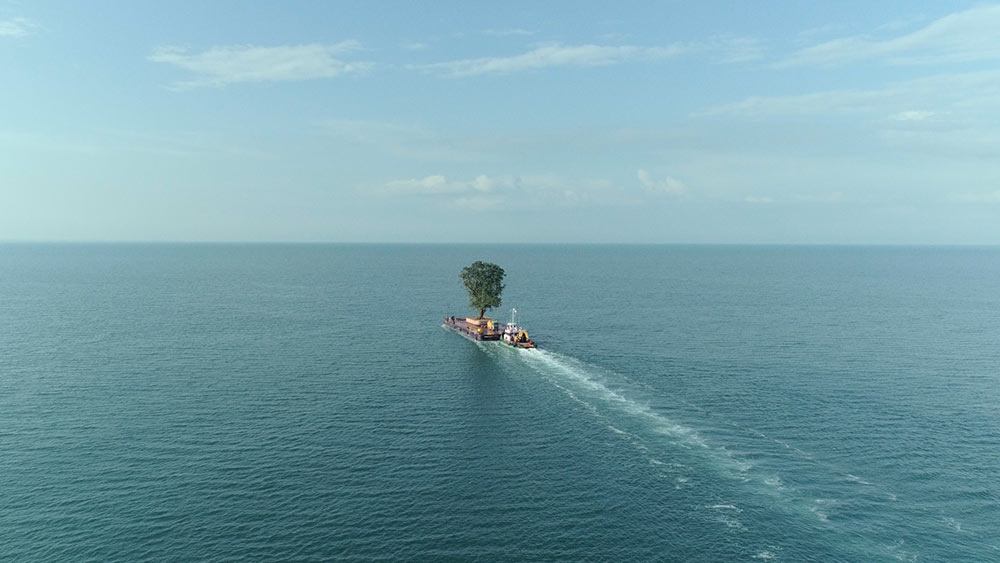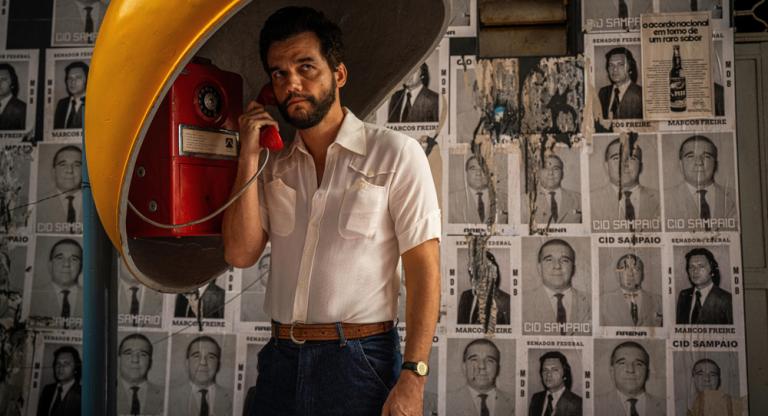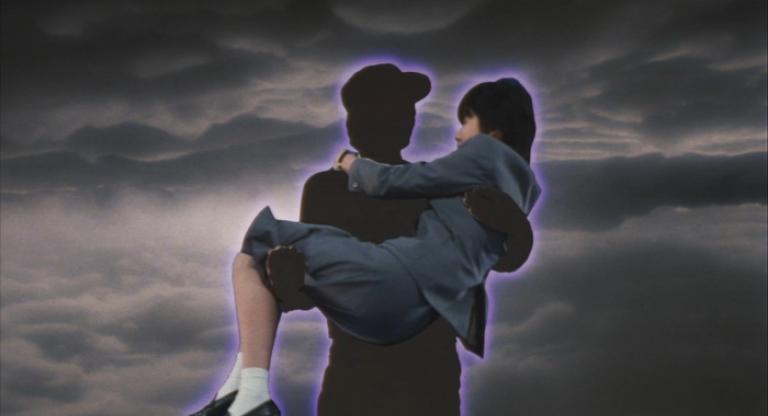Trees travel in Salomé Jashi’s Taming the Garden, a jaw-dropping record of sublime beauty and gutted community. The Georgian filmmaker chronicles the pharaonic transport of massive trees — excavated from the earth, hauled overland (and upright) inch by inch, then ferried on the Black Sea — at the behest of billionaire businessman and politician Bidzina Ivanishvili. But this is no simple story of eccentric whims; Jashi’s expansive, wide-angle views let us feel the visceral impact when towns and villages must give up 100-plus-year-old trees, like losing some part of their hearts. There’s compensation for the trees — Ivanishvili acquires them for the privately owned, publicly accessible Shekvetili Dendrological Park — but the actions come in the context of unequal power dynamics and economic woes in a post-Soviet state where Ivanishvili once served as prime minister (and where fresh post-electoral chaos erupted just last month).
Jashi’s deeply metaphorical work reaches far beyond specific circumstances in her shots of trees shifting surreally across the screen, often ringed by villagers processing it all, with glimpses of workers chatting. Taming the Garden taps primal feelings of natural communion, imposed social hierarchy, and deep ur-cultural loss in the ever-fungible 21st-century present — not to mention evoking a kind of grotesque parody of land art (or landscape films) through the transplants. Jashi builds upon the perceptive study of public spaces and traditional roles in her 2016 feature documentary The Dazzling Light of Sunset, which centers on a TV journalist and a Georgian cultural hall. Her Taming the Garden is a selection of the Berlinale’s Forum section and opens Cinéma du réel on March 12 (all of which follows its world premiere at the Sundance Film Festival).
How did you arrange to film the moving of the trees? Or to put it another way, how did you know where to be and when?
Logistically, it was a really challenging film. The excavation, the uprooting, was happening in dozens of places. I decided to work with a researcher — I definitely needed to collaborate with somebody who has a maybe more journalistic approach. In the beginning, there were several companies employed in this process. So we got access to one of them, more or less the biggest company, but then we had to establish additional contacts with other companies, and there was one region where they were totally not collaborative. They were even a little bit harassing because we were an all-women crew and they were men, and they were like, oh, if you meet me alone then I will tell you where this tree is going — you know, this kind of thing. My researcher was receiving really weird text messages.
But basically our tactic was to create a kind of web. We would go to one location, speak with them, film a little bit, meet people. And then we would go to another location, and we would tell this other location that we had filmed in this first location and that we know this and this. So they felt, okay, if they allowed you to film, we will allow you to film as well. The biggest challenge was actually finding trees where the work had not started yet. One day, this engineer took me to a place which had just been dug that morning. And I thought, you could have shown me this the day before!
Some of the work was easy to film because it was repetitive, like the drilling, which takes a day, but some things were very momentary, like actually moving the trees. I am really thankful to my team because the filming could never be properly scheduled. We would know about key actions maybe two days before, and I had to call my crew and say, we're going in two days! Or sometimes they had to go film without me. We were one crew. Our filming included a lot of driving.
It's almost comical to think that you were running to keep up with trees.
Exactly! [Laughs] We were literally running.
Even with setting things up so quickly and spontaneously, the movie has such a coherent aesthetic. What were your guiding principles, visually?
It was clear from early on that we wanted a specific look for the film — a wide lens. We were mostly using this one prime lens which was 21 millimeters. We would need to keep a distance from the subject filmed. And it's not just this subject that was important, but also the environments that the subject was in, whether it's a tree or a person. For example, the scene when the two men are talking about roads in an interior — like, “who cares where he got the money from” — this was filmed without me and I'm really happy about what my cameraman did there. He knew from our conversations that the paintings that are on the walls are also part of this whole atmosphere.
The main principle for us was to observe from afar, and not to be participants. To include details that speak for themselves, and to take time. We were not doing montage, but rather each shot tells a story by itself — that was my main principle. And since for me this topic carries a very metaphorical and symbolic meaning, almost every shot for us had a meta meaning — another layer besides what we would say in the film.
One metaphor the movie conveys so well is about the reach of wealth. The moving of the trees is so effective at making us feel the effects that a given wealthy individual can have on the lives of thousands of people — and feel it in our bones and senses. Each tree represents hundreds of years of its own life and also of the community that lived around it. And it’s a tremendous power to be able to change all that.
Yeah, absolutely. And if it was something else, if it were a house or a building, it would not have such a strong meaning because trees are really like a pillar. When I first saw the image of a tree moving on social media, it was beautiful on the one hand, but really ... When I saw it in reality for the first time, even though I was anticipating it, I felt dizzy, I felt like vomiting, which was a really interesting feeling. It meant that something fundamental was off, was shaken up. So I felt this metaphor that you just explained physically in my body. I don't think the screen can actually convey the magnitude and the dimensions of what we witnessed there and what the people witnessed. But I hope that this meaning of taking away something fundamental, like uprooting something fundamental inside ourselves, is conveyed in the film.
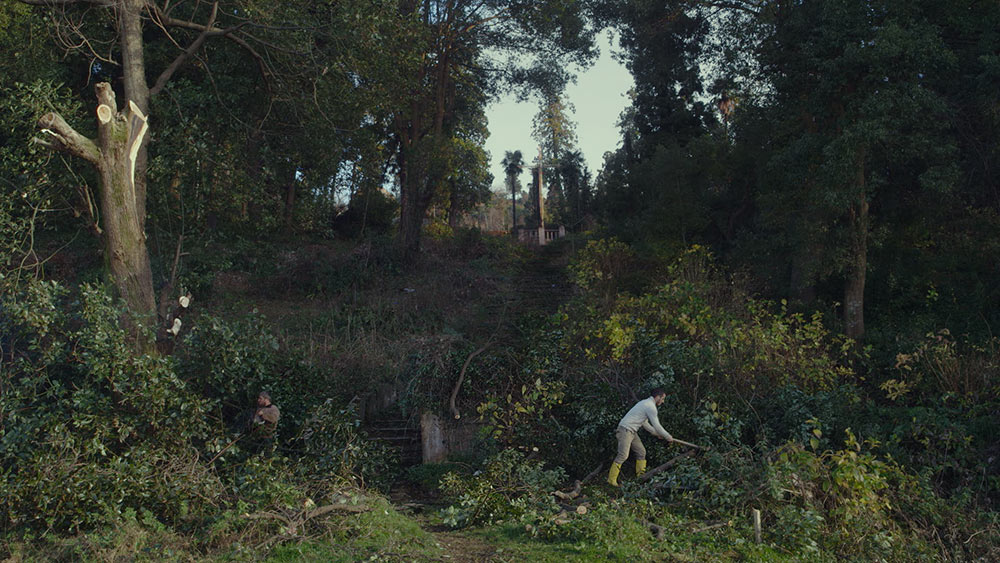
I am curious what it smelled like, because when I saw all the dirt and upheaval of the transplants, I immediately thought of a storm or an earthquake.
It smelled of gasoline.
The smell of the machinery, overwhelming nature, right. The whole activity of trying to find the biggest trees ... it’s almost a comically phallic pursuit.
Proof of manhood! [Chuckles]
I liked that your film was showing not just the spectacle, but also the emotions that it caused. Did you get the sense that people appreciated that you were there, to bear witness to what they were feeling?
No, honestly, a camera was something quite scary for many people. It was as if taking away their trees was a very private matter. Not just private, also because the trees somehow spoke about politics. And as here we live in a very fragile democracy, people don't really want to speak up about politics. They don't want to say anything about the most powerful men because they're afraid that the local governor or the central government or the police — or somebody — will create problems for them. And this man, Ivanishvili, is one of the main employers in the region, in the whole country, I think.
There are many stories that remained behind the fences. Many tragic stories, many stories of resistance as well. For example, there was a family who lived in a very shabby house with a beautiful beech tree — a magnificent tree — and they refused to sell it. Or there was a family whose tree was very dear to them, because it contained engravings of the names of the woman's parents who had died, and this woman was already old. So this tree was extremely precious to her, but her family convinced her to sell it. And as they were uprooting this tree, the tree fell and broke, basically. So I spoke to this woman, sitting in her kitchen, a semi-dark kitchen, and we were both crying because it was extremely emotional. It really feels like the death of a family member. For her, that’s what it was.
But of course there were families who were very happy to sell their trees, because they just didn't want to take care of them, because these trees would create a mess, leave a lot of leaves. So I also had this very ambiguous feeling. In the beginning I had a very straightforward feeling that, oh, when you have a strong tree, why should you sell it? But of course these people need money, because their family member has cancer or their children need to study, or for some reason. Some of them really want to get rid of it, and for others it's painful to get rid of it. So it was very diverse.
That's another thing that the movie expresses so eloquently: the bargains that the economy forces each of us to make, putting a price on things, especially if we haven’t had to do so before. That made me think of a lingering connection to the country’s transition from the Soviet Union.
I agree, money became the main value. All the other values were pushed back. And in terms of Soviet Union, yes, it's a kind of Soviet inheritance: when you have a powerful person, whatever the powerful person says, you have to comply with it. There was a woman who told me once, “Who am I in comparison to him to express myself?” I can generalize this sentence — any other person in the film or outside the film could have said that.
It’s also interesting how you portray women and the tension of traditional roles and the wisdom of experience. One of the people that I was most impressed with in Taming the Garden is the woman who must be in her 80s or 90s. Her son or grandson is musing about a deal to get a new road in exchange for the trees, and she's like, “What are you talking about? They’re never going to do that.”
In the beginning, I was thinking of not having any women in the film, and having just men. That it should be a representation of men, because this whole action does represent men, the way they are today — [laughs] certain men — in Georgia. Very macho, masculine, phallocentric — to be very direct. The women naturally came into the film, and they do play a bit of a different role: they are either the victims, or the ones who express themselves. For example, there is an older woman who I adore, who says, this tree was so majestic, it was full of moss before — she describes it in a poetical way. And then she says that it looks smaller now. And another woman says, but they trim the branches, and the older woman says, I don't mean the branches, the trunk seems smaller. Of course, the trunk is the same size, but as soon as the tree loses its space, it loses its magnetism, it loses its grandiosity. So it's true that the women became the ones who really felt what was going on, and who expressed things.
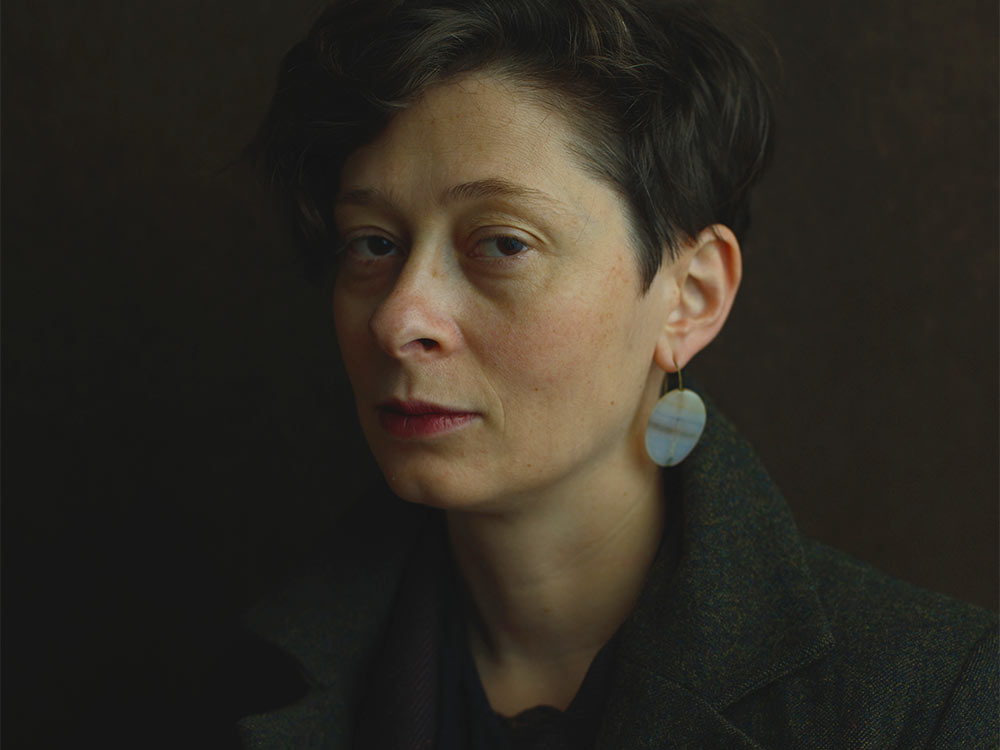
Coming back to the process of filming, how did you manage to shoot from stable positions and have such well-composed frames?
When the tree was moving, that was probably the most challenging thing to film. Because when you feel a person moving, you can anticipate how they will come into the frame and when they are getting close. With a tree, you can never really anticipate it, it was so strange and interesting. It was actually a challenge to keep a balance. When you film a person, you film a human perspective, like an “I” perspective. This is my approach usually. But when you have a tree, what is your perspective? Those were the questions that we had to think about and try different things. And when we had a wide shot of a tree, it always made sense to try to find a higher place, so that we would not be looking from really low up at the tree. We had several locations where we set up the camera and the tree would come in and we thought it would fit properly, but it would be like halfway there or very small. It was so strange to anticipate, to understand the dimensions of it as it moved.
I couldn’t help but think of Fitzcarraldo a little with this whole process of moving trees. Which filmmakers are important for you?
Concept wise, of course it is a very Fitzcarraldo idea to move something that is not movable in a place where it cannot be moved. In terms of visual style, I have several filmmakers who have influenced me at different times. One of them is Sergei Dvortsevoy. And some documentaries of Sergei Loznitsa. I'm a big fan of the visuals of Leos Carax. And I adore Ulrich Seidl, not just because of his visual approach but also for his subversiveness — showing the horror a little bit, human nature.
I also thought of Sharon Lockhart’s Pine Flat a little, though it’s quite different, partly because of the soundscapes in that film. Could you talk about the sound design in Taming the Garden? For example, when you show the arboretum, it’s wild — is that live sound, or a mix of things?
It was not such a high-budget film, so we were not so well-prepared for sound. I should say that the sound designer Philippe Ciompi did a great job. We had another session of several days of recording only sound. I had a sound recordist go on location and record as many related sounds as he could. So I think it impacts our soundscape quite a lot. But music plays a really big part in the sound as well, especially at the end. What you hear at the end is the birds that are in the park, but also my music consultant brought this idea to include a vocalist, Uta Wasserman, who makes artificial bird sounds. So we enhance these natural exotic bird sounds with her voices. The birds start low, and then it’s enhanced with these machines, with the birds, and more and more and more, and it's this triumphant music of the climax — of the “winner.” We had so much fun on this last sequence.
It's a terrific sequence, because the climax is the achievement of this fantasy. It’s terrible and violent how they transplant trees to make the arboretum, but the result is still a striking spectacle.
When we were editing at the end, we had the idea that we are on one shore — where all these excavations happen and all this drama with the people, the trees, the workers — and then the tree crosses the water, and it's like crossing the Styx from the Divine Comedy: it arrives in a different world. So with the park, we wanted to create a totally different world. This is like Heaven or Hell. One idea I had about this place was that it would be like the heaven from the magazines of Jehovah's Witnesses. [chuckles] No offense to Jehovah’s Witnesses. But this glossy heaven! It shines. It's unreal. It’s so colorful. It’s non-existent but it exists. So it was this artificial heaven basically that could also be a hell. We wanted to have this confusion: is it a heaven or a hell, is it good or not good. The sound also contributed to that.
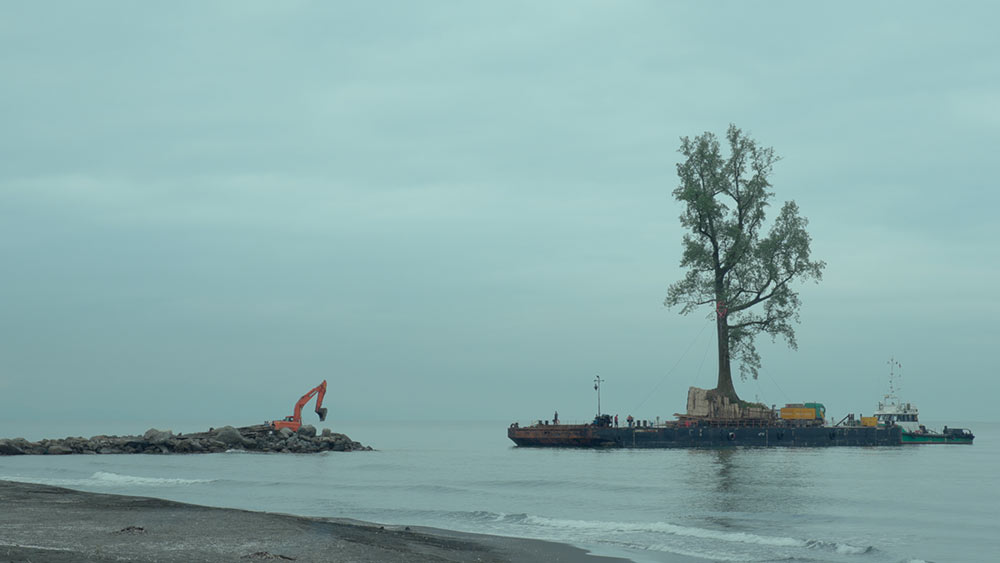
Have you heard from Bidzina Ivanishvili?
Well, not from him directly but yes. Soon after the film screened at Sundance and after I gave a couple of interviews, here in Georgia as well, the big pro-governmental TV channel published “news” — basically a statement by one of his representatives of his foundation that governs his estates. The guy was saying that I had been lying when I say that it's his private garden. That in fact he gave it to the people, that he did it for the people. The park was open to the public this summer, and he says that it's open for the people, but it is a totally private estate. Actually, legally, it belongs to his son. The park is next to his summer residences, it’s next to the big hotel that he owns by the seaside. So they were upset that I was saying that this was a private park. But clearly it's one person's initiative, one person’s caprice. And they were upset about the title. But earlier this week I invited some people to watch the film — I invited the main engineer who was supporting us and what we're filming, and basically gave us access. And they seemed fine, they didn't see such a big criticism. The engineer is a very intelligent person and he took the film as something not so dangerous for the billionaire.
But I'm curious what will come. Another interesting thing involved the two channels — one of them the public broadcaster, the other this pro-governmental channel. There are two Georgian films at Berlinale. One of them is in competition. And they would cover only the other film, and they would totally ignore this film, not mentioning it at all. I think there will be more to come, more reactions to come, it’s very subtle.
I read about his foundation, which makes extensive donations, but that obviously can just give a different kind of power over institutions.
Yeah, exactly. He wants to be this philanthropist who supports artists or renovation of certain theaters, or who supports people. But it's very, very ambivalent, what this does.
Thinking about themes we were talking about, perhaps it's paternalistic, too.
It is. Actually “paternalistic” is a very correct word because that's also why he came to politics — to patronize — and then he retreated from politics. “Now you do it yourself. I will just look over at you, like a parent looks over a child.” It’s this kind of attitude.
Public space is a common theme in both Taming the Garden and The Dazzling Light of Sunset. With Dazzling Light, it’s interesting to see all the things that happen in this cultural hall, and the values that are put forth there. And here, these trees represent a public space, a communal institution.
I'm really interested in spaces. I mean, you call it public spaces, but what I'm really curious about is spaces and environments and how these spaces and environments affect people. My first big film, a mid-length film, is also about a space and the people in this space. And in the beginning what inspires me in the first place is space. For example, in The Dazzling Light of Sunset, it was the wallpaper that was torn down at the end that was inspiring for me, and then came of course the people who are working in front of that wallpaper. So the elements of the environment are the starting point for me, and then I observe the people who happen to be there and are affected by the space and environment.
Where did you grow up in Georgia?
I grew up in Tbilisi. I was born here, I went to school here, but a place that influenced my childhood a lot was my village house. I think my affection for trees also comes from that time, because we had an old house, a 100-year-old shabby wooden house. And there was a big walnut tree right in front. When there was a thunderstorm, this house would shake [makes a rumbling sound] — this sound of creaky wood and glass — and as children, we were afraid that this walnut tree would break and fall on this house. But this walnut tree ... Maybe it's something that came from my mother or from my grandmother or the other grandmothers that were there: it was really the symbol of strength in our backyard.
There was a mulberry tree — you know, the white and black fruits that we eat here but I haven’t seen others in Europe eat it. And we had a round table right under this tree, and these big rocks where we would sit. So this tree was the center for gathering, eating dinners together, and there were like 15 children in this yard, from the old house and the new houses next to it. A big space with three grandmothers, 15 grandchildren. And there was yet another tree which was thick and its branches went like this, so you could just go up there, five or six kids, and sit like it was a table. Or there was another, an apple tree, that I associated with my brother very much because he used to like to hang on it. He was small, younger than me, and this apple tree was also smaller. So every tree there had a big symbolic meaning. We had huge pine trees as you would enter the yard that could be seen from everywhere in the village. And I think of losing each tree — that walnut tree was cut down afterward because it died, and another walnut tree was planted in its place, the same but young, with hopes that it would grow for 100 years.
So from those village times, I really have this connection to the trees and understanding what a tree can mean for a person. One day, one of the grandmothers cut down one of the pine trees, this beautiful pine tree. And we as children were astonished — why did she cut it? And she cut it down because she had a dream. She had a dream that this tree fell and it meant the death of her husband or herself or something. So she cut it down just because of a dream that meant something really important. So these trees had in my childhood a very metaphysical meaning. I think this understanding, this attitude, is also in the film.
Every tree having its own story. Do you know what you're going to film next?
Yeah, I'm thinking of an archive film.
Something a bit more contained?
Something more stationary. [Laughs]
